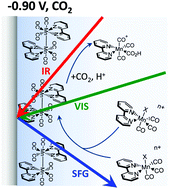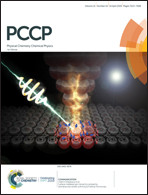In situ study of the low overpotential “dimer pathway” for electrocatalytic carbon dioxide reduction by manganese carbonyl complexes†
Abstract
The electrocatalytic reduction of CO2 using [fac-Mn(bpy)(CO)3Br] (bpy = 2,2′-bipyridine) and its derivatives has been the subject of numerous recent studies. However the mechanisms of catalysis are still debated. Here we carry out in situ vibrational sum-frequency generation (VSFG) spectroelectrochemistry to examine how this catalyst behaves at an electrode surface. In particular, a low overpotential pathway involving a dimeric manganese has been reported in several studies using substituted bipyridine ligands. Here, we find that the “dimer pathway” can also occur with the unsubstuituted bipyridine complexes. Specifically we can observe spectroscopic evidence of the interaction between [Mn2(bpy)2(CO)6] with CO2 in the presence of a suitable acid. Detailed VSFG studies of [Mn2(bpy)2(CO)6], including of the potential dependence of the surface ν(CO) mode, allow us to construct a model of how it accumulates and behaves at the electrode surface under potentiostatic control.

- This article is part of the themed collection: 2019 PCCP HOT Articles


 Please wait while we load your content...
Please wait while we load your content...